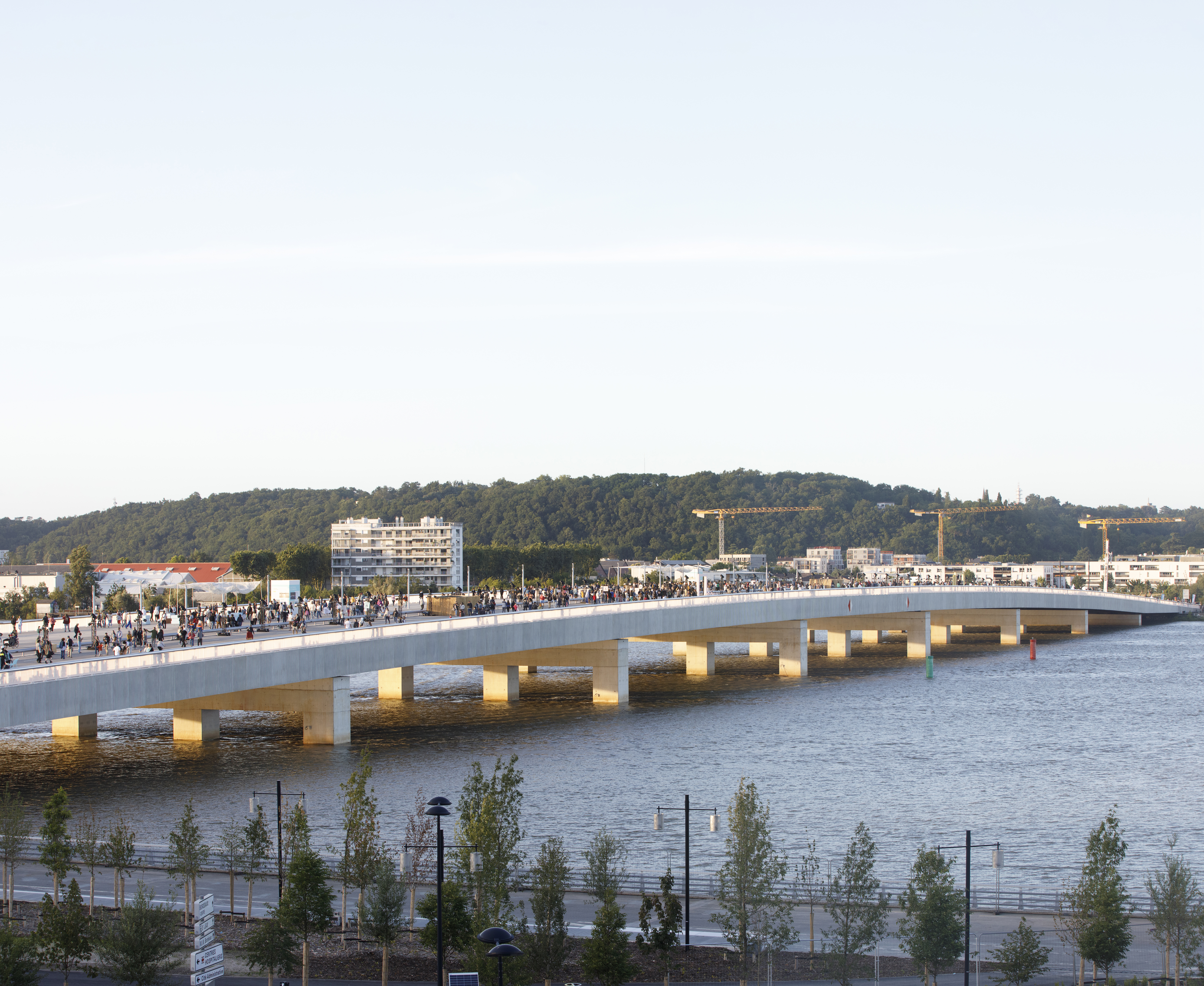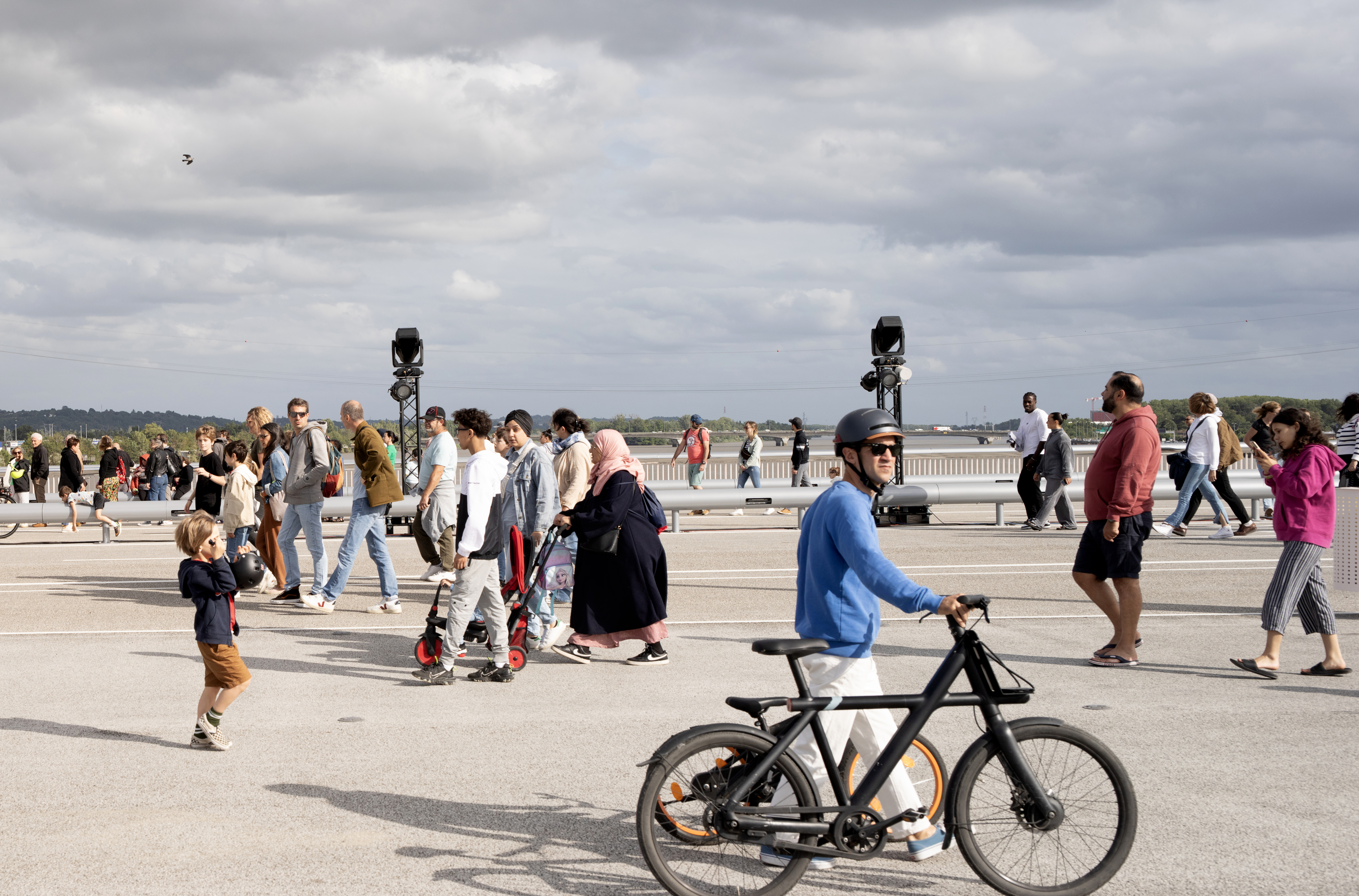
2024年7月,由OMA / 雷姆·库哈斯(Rem Koolhaas)与克里斯·范杜恩(Chris van Duijn)设计的西蒙娜韦伊大桥(Simone Veil Bridge)正式启用。本项目坐落于法国波尔多加龙河(River Garonne)上,呈一座549米长、44米宽的平台由一侧河岸伸展至对岸。
The Simone Veil Bridge, designed by OMA / Rem Koolhaas and Chris van Duijn, has opened. The project consists of a platform stretched across the River Garonne in Bordeaux that is 549 meters in length and 44 meters wide.

大桥为该市带来全新的公共空间。其摈弃对风格、形式和明显的结构表现的追求,致力于使用性能并关注未来能够为波尔多市民所能提供的用途。私家车、公共交通以及自行车均设有各自专属的车道,同时为行人留出了最宽的路面空间。加倍的桥面宽度,创造了一个达28米宽,未有设定指定功能的空间,可用于举办任何文化或商业活动,例如市集、艺术展览、赛事、车友会聚会、音乐节或美酒节等。
The bridge provides a new public space for the city. It abandons any interest in style, form, and structural expression in favor of a commitment to performance and an interest in future use by the people of Bordeaux. Cars, modes of public transportation, and bicycles all have their own lanes, with the largest by far dedicated to foot traffic. The width of the bridge’s platform is doubled to create 28 meters of neutral, unprogrammed space that can be used for any cultural or commercial purpose, such as farmers’ markets, art fairs, bicycle rallies, car club meetings, and festivals for music or wine.



如今,人们常以桥的技术性效用和作为城市及周边的扩展工具的功能,来狭隘地衡量桥梁的作用价值。桥自身承载的城市空间功能已丧失。然而西蒙娜韦伊大桥的做法,摈弃了当前人们对桥梁在工程壮举或美学表现上的痴迷追求,让桥梁重新恢复为充满活力的城市公共活动空间。其理念参考多座不仅是通行场所,还是城市休闲及商业活动空间的桥梁,其中包括威尼斯的里亚托桥(Rialto Bridge)和十九、二十世纪横跨伊斯坦布尔金角湾(Golden Horn)的加拉塔桥(Galata Bridge)。不同形式的交通及活动交织在一起,形成一条有着多种不同使用场景的当代城市大道,为波尔多的大都会生活增添活力。西蒙娜韦伊大桥的设计旨在能够适应未来各种可能的用途。这座大桥让大众对波尔多大都会生活产生热切乐观的期待。
Today, bridges are often narrowly evaluated in terms of their technical utility and their function as tools for the expansion of the city and its periphery, largely driven by cars. The role of bridges as urban spaces in themselves has been lost and is in need of resurrection. The Simone Veil Bridge opposes the current obsession with bridges as triumphant feats of engineering or aesthetic statements and recovers their urban character as open spaces where events can happen. This is an alternative definition of what a twenty-first-century bridge can be. Its points of reference are bridges that are places not only for circulation but also for leisure and commercial activities—including Venice’s Rialto Bridge and incarnations of Galata Bridge across the Golden Horn in Istanbul in the nineteenth and twentieth centuries. Bringing together different forms of traffic and potential actions creates a contemporary boulevard that can exist in various configurations of intensity. The bridge contributes to a strongly optimistic expectation for the metropolitan life of Bordeaux.



此项目设计旨在为加龙河两侧沿岸地区建立一个具连系性的形象。河的右岸为弗卢瓦拉克 (Floirac)新开发区,排布着富有雕塑感的多座公共设施建筑,而左岸为波尔多与贝格勒(Bègles),两岸通过巧妙地交织于城市肌理之中的绿色空间,以及废旧公路的更新改造,连接串联在一起。这座大桥不仅通过物理空间上的连接,同时亦以景观中的城市平台,为这座城市提供重要的连续性。
The Simone Veil Bridge is conceived to create a linked identity for the areas on either side of the Garonne. It connects the development of Floirac on the right bank, where sculptural and functional objects are arranged to provide public amenities, with Bordeaux and Bègles on the left bank through green space that is subtly woven into the urban fabric, including with the reuse of a former highway. The bridge provides fundamental continuity for the city’s territory, through connection but also through its performance as an urban platform in a landscape.


本项目由雷姆·库哈斯和克里斯·范杜恩领导设计,由Gilles Guyot带领团队工作。
This project was undertaken by Rem Koolhaas and Chris van Duijn, with key contributions from Gilles Guyot.

OMA合伙人雷姆·库哈斯表示:“这座桥是为市民而非行家而打造。该项目注重的并非外观形式,而是其使用性能。相较于把成本预算花在结构形体上,本项目反而是致力使大桥获得倍增的桥面宽度,从而创造了一个线性的公共空间,服务于两侧沿岸的社区并为它们建立连接。而这两侧沿岸目前尚未发展形成一个强烈的形象特征。如参考里亚托桥这类型的桥梁案例,这个额外的公共空间可以用于各种性质的用途:无论是大众的、商业的还是文化类的活动,又或者是集会。”
Rem Koolhaas, Partner, OMA: “This bridge is for the people, not for connoisseurs. Rather than concentrating on form, the project focuses on performance. Instead of spending its budget on structural gymnastics, it doubles the width with a public space to serve and connect the two adjoining communities that so far have not developed a strong identify. On the model of bridges like the Rialto in Venice, this extra public space can be used for any purpose: popular, commercial, cultural, political...”
OMA合伙人克里斯·范杜恩表示:“我们设计打造的西蒙娜韦伊大桥,就如一个跳出剧场空间之外的舞台。在当前标志和地标遍布的时代,波尔多市建造这样一个与标志性相悖的设计这是一个具有特别意义的决定。”
Chris van Duijn, Partner, OMA: “Our design for the Simone Veil Bridge is like a stage but without the theatre. In an era of icons and landmarks, it is very special that the city of Bordeaux decided to build this anti-iconic design.”
OMA项目经理Gilles Guyot表示:“为了发挥其功能,项目的身份存在感需要逐步淡化,成为一个可容纳各种可能性的开放平台,由一条连系城市的纽带变为城市活力之源。”
Gilles Guyot, Project Manager, OMA: “To do its duty the project needs to fade away, to be an open table for possibilities. The ruban has become urban.”




完整项目信息
状态:完成
业主:波尔多都会区
位置:法国波尔多,贝格勒市和弗卢瓦拉克市
项目基地:Jean Jacques Bosc 大道,加龙河上
年份: 2013年—2024年
功能内容:大桥:549米长,44米宽
120,000平方米的桥头堡,包括道路、地下行车道、公共空间和公园
合伙人
雷姆•库哈斯 (Rem Koolhaas)
克里斯•范杜恩 (Chris van Duijn)
项目建筑师
Gilles Guyot
设计团队
Clément Blanchet、Margarida Amial、Henry Bardsley、Denis Bondar、Kimiko Bonneau、Solène de Bouteiller、Alice Chen、Emily Crabb、Alban Denic、My-Linh Dinh、Paul Feeney、Camille Filbien, Marc-Achille Filhol、Stavros Gargaretas、Romina Grillo、Hanna Jankowska、Henri Kapynen、Min Hong Khor、Sang Woo Kim、Pierre-Jean Le Maitre、Pierre Levesque、Salma Maaroufi、Lawrence-Olivier Mahadoo、Pierre-Jean Le Maitre、Deborah Mateo、Edward Nicholson、Ana Otelea、Jerome Picard、Ana Reis、Maria Aller Rey、François Riollot、Claudio Saccucci、Irgen Salianji、Kristin Schaefer、Sai Shu、Helene Sicsic、Lukasz Skalec、Saul Smeding、Ida Stople、Jan Szymankiewicz、Xavier Travert、Nicola Vitale
合作单位
工程:科进、Groupe EGIS
景观:Michel Desvigne Paysagiste
灯光照明:Les éclaireurs
施工承包单位
前期工作:Dubreuilh, Etchart Construction, Menard
土木工程、设备及上部结构:Bouygues Travaux Publics Régions France, Pro-fond
钢结构:Baudin Châteauneuf
道路与网络:Colas, Aximum
绿化空间:ID Verde, Brettes Paysagiste
灯光照明:SPIE City Networks
编辑 / 李翊娴
视觉 / 饶安林 校对 / 李翊娴
本文编排版权归有方空间所有。图片除注明外均来自网络,版权归原作者或来源机构所有。欢迎转发,禁止以有方版本转载。若有涉及任何版权问题,请及时和我们联系,我们将尽快妥善处理。邮箱info@archiposition.com
上一篇:“临崖”与“框悠” / 大小景观
下一篇:秩序回应艺术:iag美术馆 / 彼山设计